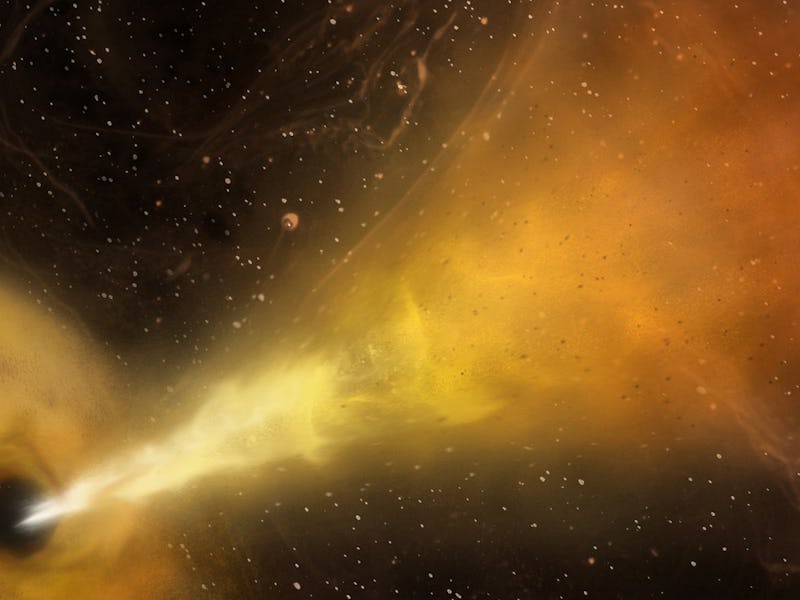
There’s no worse morning after than the one following a hot night of spicy food: Exits are, somehow, always grander than entrances. Perhaps nothing knows this better than a supermassive black hole that’s just swallowed up a fiery star, like the one imaged by researchers in a Science paper published Thursday. The hot jet emanating from this greedy gravity pit’s dark core does not look comfortable.
In the paper, the team explains that capturing the data that led to this stunning image of a “tidal disruption event” — a fancy name for a black hole’s savage star meal — was a project that’s been ongoing since 2005, when astronomers caught bright bursts of infrared and radio wavelengths coming from a galaxy called Arp299, about 150 million light-years from Earth. Now, using a decade’s worth of data, they’ve managed to produce an image of its gluttonous source — and better understand where that burst was coming from. As it turns out, it was the electromagnetic signature of the hot burp — a relativistic jet — emanating from the supermassive black hole at Arp299’s center.
Arp299 is actually two galaxies: Arp299B is the evil twin of a galaxy called Arp299A, but the two are in the process of merging. The black hole at Arp299B’s core apparently got hungry during the merge and sucked up a local star twice the mass of our own sun. It proved to be much more than a snack: The black hole, which has a mass equivalent to 20 million Suns, belched up a blazing jet of fiery star debris, which is ultimately what reached telescopes here on Earth.
Arp299A (left) is merging with its evil twin, Arp299B (right). At their nexus, Arp299B's black hole is burping up the remains of a spicy star meal.
Tidal disruption events are rarely spotted, so scientists are still beginning to understand how they work. Fortunately, scientists recently developed a computer model synthesizing that data to show what actually happens when a black hole sucks up a star, which Inverse described in a previous article with the help of the diagram below:
A schematic showing what actually happens as a star (represented by the red-orange debris stream) gets sucked into a black hole.
First, the star begins disintegrating into a disk of debris called an “accretion disk” because the black hole’s gravitational field is so strong. The black hole eats up all the debris (the slim part of the orange-yellow gradient), and once that debris enters the black hole, it gets “spaghettified” — stretched vertically and compressed horizontally into noodle-y streams of atoms — and slurped up.
However, the black hole can become “overfed,” so some stellar debris hangs out around the mouth of the black hole, not unlike crumbs left over on a facial beard (the fat part of the disk). These crumbs are important, because they’re what we can see from Earth: The process of getting sucked up is a hot one, and as the debris heats up, it emits light and radiation (shown as a double-headed arrow in the image), which we can detect from Earth.
In a previous interview with that paper’s lead author, University of Copenhagen astrophysicist Lixin Dai, Ph.D. told Inverse that the jet of hot air streaking out from the black hole’s center after it eats a star is “a stream of highly energetic particles moving almost at the speed of light, ejected along the polar axis of the disk.” The jet pictured spewing out of Arp299B’s black hole is exactly that — and part of the reason scientists were able to image the event in the first place.
Only a few tidal disruption events have been detected; here's one reported by Johns Hopkins University scientists in 2015.
Seppo Mattila, Ph.D., a University of Turku astrophysicist and co-author on the new paper, explained in a statement on Thursday that the signals that have been detected from Arp299 since 2005 were strongly bright at infrared and radio wavelengths but not in visible light and X-rays. He now thinks that the signal came from the jet, but the reason it showed up in such specific wavelengths is that the dust at the core of the colliding galaxies “absorbed the X-rays and visible light, then re-radiated it as infrared.” Now, astrophysicists hunting for these gluttons know to look for infrared and radio wavelengths.
While tidal disruption events were once thought to be rare, Mattila and his colleagues are encouraged by their find. They think there may be many more of these hungry star fiends out there, slurping down hot stars and paying the price.